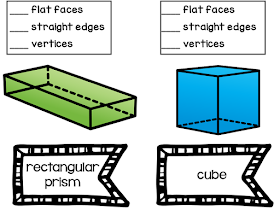 I
taught 3rd
grade in Texas for 15 years. I had the
opportunity to administer several Texas Assessments....including
the STAAR.
Each year, teaching geometry to prepare for the assessment seemed a bit of a mystery.... especially the 3
dimensional shapes. As I taught the attributes of the 3 - D shapes, I had unanswered
questions. Let’s just say that I didn’t
feel that I was knowledgeable in this area, and the information given to me to
teach the skill was not much help. I did
the best I could and even did some outside research, which helped a little bit, but didn't clear up my main questions. I have changed grade levels since then and
hadn’t given it much thought until now.
As a 1st
grade teacher, I have recently began having the same questions that I had as a 3rd
grade teacher. We are going to be introducing Geometry soon, so I am feeling the need to make
sure I am teaching my first graders correctly. So... more research to see if I can find the answers this time.
I
taught 3rd
grade in Texas for 15 years. I had the
opportunity to administer several Texas Assessments....including
the STAAR.
Each year, teaching geometry to prepare for the assessment seemed a bit of a mystery.... especially the 3
dimensional shapes. As I taught the attributes of the 3 - D shapes, I had unanswered
questions. Let’s just say that I didn’t
feel that I was knowledgeable in this area, and the information given to me to
teach the skill was not much help. I did
the best I could and even did some outside research, which helped a little bit, but didn't clear up my main questions. I have changed grade levels since then and
hadn’t given it much thought until now.
As a 1st
grade teacher, I have recently began having the same questions that I had as a 3rd
grade teacher. We are going to be introducing Geometry soon, so I am feeling the need to make
sure I am teaching my first graders correctly. So... more research to see if I can find the answers this time.
Here
are the questions that had been perplexing me:
•Do
cones, spheres and cylinders have faces, edges and vertices? If not, why do all of the worksheets ask questions about it?
•Do
you treat cones, spheres and cylinders just
as 3 dimensional figures with polygons as faces?
I
had always thought that 3-d shapes with curved edges should not have the same
types of questions as the shapes without curved edges. I thought that asking for the faces, edges,
and vertices on shapes with curved edges was confusing. But, it seemed like every product I could
find asked those very questions.
Including my own!
Finally, I
found my answers.... on a Released STAAR Assessment. As a 3rd grade teacher, I had noticed that the questions on the assessments never asked about faces, edges and vertices on shapes with curved edges.
So, I
decided to look at what questions were being asked about 3-D shapes. I thought
that finding questions about 3-D shapes might clear things up. I was so RIGHT! Here is a snip of the questions
that answered my questions.
(3rd Grade STAAR 2016) As well as a snip about the vertex of a cone. Click the link for more information.
CHECK THIS OUT!
The answer is "F". Just as I suspected The 3-D Shapes with curved edges do not have vertices. Look at answer choice "H". They also do not have edges.
Clearly these shapes have edges, but the edges they are referring to are straight edges. The same goes with vertices. (See snip above.) So... we need to be teaching our students that when we look for faces, edges and vertices, we are looking for flat faces and straight edges. And also, we need to share the information above about the vertices (vertex) of any shape.
So, with this finding, I will stop asking the wrong questions about 3-D Shapes with curved edges. And I will pass this information along to my coworkers.
I hope this has helped you in your quest to be the Best Teacher possible.
I know I will be teaching differently now!
I am working on a product for primary geometry at this time.
I will be posting it within a couple of weeks. :)
Here's a sneak!!
This page is part of an anchor chart for teachers to build. Notice, I have added some clarifying adjectives about the attributes of the shapes. (Flat Faces and Straight Edges) I feel that this will make it easier to understand and answer the questions.
This page is part of an anchor chart for teachers to build. Notice, I have added some clarifying adjectives about the attributes of the shapes. (Flat Faces and Straight Edges) I feel that this will make it easier to understand and answer the questions.
Thanks for stopping by!
Carrie
credits: Whimsy Clips, KG Fonts





No comments:
Post a Comment